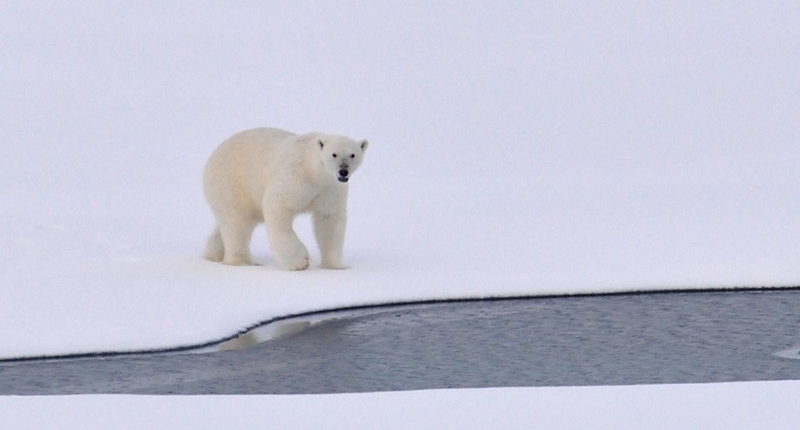The polar regions are breaking down, and this is leading to instability across the rest of the world. The North and South Poles help regulate the world’s climate and weather, but they are in crisis and warming faster than the rest of the world. Polar breakdown creates extreme pressures on food and water security, heat stress in cities and climate vulnerable regions, more extreme weather, and supply chain disruptions. The Arctic sea ice reflects much of the sun’s energy back to space, and since 1971, we have lost about 50% of that ice. If we lose the Arctic snow and ice, it will magnify global warming by 25-40%. The Antarctic is the last great barrier we have against out of control climate change. As those insurance policies disappear, we face socio-economic and ecological impacts linked with Arctic warming costing billions of dollars per year. Cutting emissions in half by 2030, no new fossil fuel exploration, investment or subsidies, and protecting nature are solutions that already exist to climate change.
The Crucial Role of Polar Regions in Mitigating Climate Change
The North and South Poles play a vital role in regulating the world’s climate and weather patterns. Despite this, they are currently in a state of crisis, warming at an alarming rate, which is three times faster than the rest of the world. Scientific evidence indicates that nine of the 16 critical global climate tipping points, including five of the six closest to tipping, are in the polar regions.
The poles are the control center for our climate system and significantly impact the Earth’s atmospheric and oceanographic circulation systems. Therefore, changes in the Arctic and Antarctic regions have implications for the rest of the world. As such, the warming of the poles is a cause for concern since it threatens to undermine the world’s efforts to mitigate climate change.
The Intergovernmental Panel on Climate Change (IPCC) recently released its latest synthesis of climate science, stating that irreversible climate catastrophe is imminent unless we take action to cut emissions. It is essential to understand that climate change is not limited to arid deserts and punishing heatwaves. Instead, it encompasses melting ice sheets near the North Pole, which is equally alarming.
The poles are our powerful insurance policies against runaway climate change. If we fail to take decisive action to curb emissions, the breakdown of the control center of our climate system will exacerbate the crisis. Therefore, we must act fast to prevent the risks to society and business that are associated with global warming.
In conclusion, the North and South Poles have a significant role to play in mitigating climate change. Their warming trends are alarming and threaten to undermine the world’s efforts to reduce emissions. Thus, the world must take action now to address the issue and prevent the catastrophic consequences of runaway climate change.
The Importance of Polar Regions in Climate Change Mitigation
Polar regions play a significant role in mitigating climate change. Arctic sea ice reflects much of the sun’s energy back into space, keeping our planet cooler. Unfortunately, we have lost approximately 50% of that ice since 1971 due to global warming, which melts the sea ice and exposes the ocean, resulting in more absorption of the sun’s energy and warming up. This trend will magnify global warming by 25-40% if we lose the Arctic snow and ice, according to scientific estimates.
Antarctica is the last significant barrier we have against out-of-control climate change, but its sea ice minimum has set another record low, indicating the urgency of the situation.
Moreover, Arctic permafrost acts as another polar insurance policy by storing a large volume of carbon. However, if permafrost thaws, it releases the greenhouse gas methane, which will eat up to 40% of the remaining carbon budget to keep us within 2℃ warming, according to scientists.
As these insurance policies disappear, polar breakdown creates instability across the rest of the world, leading to extreme weather conditions, such as cold spells, superstorms, hurricanes, cyclones, droughts, fires, and flooding. These extreme events, such as the blizzard that struck Los Angeles in February 2023, directly contribute to climate change and, if they continue to become the norm, will lead to food and water insecurity, heat stress, supply chain disruptions, and more.
The polar regions’ health directly affects the 17 UN Sustainable Development Goals, indicating the urgency of the situation. Therefore, it is essential to address the issue by cutting emissions and taking decisive action to prevent further damage to our planet’s delicate balance.
In conclusion, polar regions act as a critical control center for mitigating climate change. As we lose these vital insurance policies, the instability created by polar breakdown has implications for the rest of the world, leading to extreme weather conditions and other severe consequences. The urgency of the situation necessitates action to reduce emissions and protect the health of the planet and its people.
Urgent Action Needed to Address Climate Change Impacts
Communities worldwide are already experiencing the effects of climate change, including droughts, floods, and rising sea levels. The World Economic Forum’s Global Risks Report continues to rank these environmental threats at the top of the list, emphasizing the need for immediate action to mitigate them.
To achieve the Paris Agreement’s goals of limiting global temperature rise to well below 2°C and as close as possible to 1.5°C above pre-industrial levels, businesses, policymakers, and civil society must take comprehensive near- and long-term climate actions.
The World Economic Forum’s Climate Initiative works to accelerate global climate action through public and private-sector collaboration. The Alliance of CEO Climate Leaders is a global network of business leaders from various industries who are developing cost-effective solutions to transitioning to a low-carbon, climate-resilient economy. Through their influence with policymakers and corporate partners, these leaders aim to accelerate the transition and achieve the economic benefits of a safer climate.
The effects of Arctic warming, according to estimates, result in billions of dollars per year in global socio-economic and ecological impacts leading to the 2050 net-zero target. Arctic warming poses material risks for companies in agriculture, supply chains, water, coastal communities, and real estate.
The disruption of supply chains, such as the Rhine River during summer 2022 in Germany, which takes 80% of shipping raw materials through inland Europe, is an example of the impacts of climate change. The route stopped due to drought conditions last summer, highlighting the need for immediate action.
Cutting emissions in half by 2030, rejecting new fossil fuel exploration, investment or subsidies, and transitioning towards clean energy are solutions to mitigating climate change. Business leaders have already developed a roadmap to transition industry towards clean energy, align financial flows with net-zero, and protect nature. The adoption of these solutions requires action at scale, and there are no silver bullets.
In conclusion, the need for immediate action to mitigate the effects of climate change cannot be overemphasized. The World Economic Forum’s Climate Initiative and the Alliance of CEO Climate Leaders aim to accelerate the transition to a low-carbon, climate-resilient economy. Cutting emissions, rejecting new fossil fuel exploration, and transitioning towards clean energy are among the solutions to mitigating climate change.
The polar crisis affects the entire world and requires global action to address it. Adaptive solutions and a convening body must be put in place to mobilize the world to unlock and tackle the challenges. Starting today is crucial. Readers can create a free account to access personalized content with the latest publications and analyses from the World Economic Forum. The content is licensed under Creative Commons Attribution-NonCommercial-NoDerivatives 4.0 International Public License and in accordance with their Terms of Use. The author’s views expressed in this article are theirs alone and not of the World Economic Forum. The Global Agenda provides weekly updates on the most critical issues that drive the global agenda.
Don’t miss interesting posts on Famousbio









